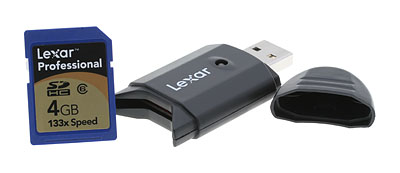The new cards promise the potential of write speeds up to 20MB per second, according to the company. Expected retail is $149, and the market is anyone owning an SLR compatible with SDHC who wants to shoot RAW instead of, or along with, JPEG images. SDHC cards only work in cameras and readers built to support the new standard, so Lexar is including a small reader with the card. I tested both.
Slipping the gold and blue card into a nearby Nikon D80, I began my testing. First I wanted to see how it performed in the camera, where speed matters most. I set the camera to ISO 1,600 to speed things along in terms of shutter, but also to add the factor of noise, which usually makes the images harder to compress. I set it to continuous mode, and set the quality to RAW plus JPEG Fine.
I was still limited to six frames before the buffer filled; no surprise there. But the buffer clearing time was about two seconds faster than the SanDisk Extreme III SD card we used for the original D80 test back in summer, 2006: 11.7 seconds compared to 13.8. Any improvement in buffer clearing time is good.
It took some time to fill the card, which ultimately held 544 files total, for 272 pairs of images (one RAW, one JPEG). Each RAW file was 10.3MB, and the accompanying JPEGs averaged 4.5MB. If you remember that a Megabyte equals roughly a million bytes, and that each byte is 8 bits: well, that's a lot of ones and zeros flying around very fast (1 megabyte = 8,388,608 bits, so those six shots total 744,908,390 bits. But I digress).
Next came copying the full card to a computer. Most people copy from the camera to the computer, so I used a USB 2.0 cable between the Nikon D80 and my iMac G5 1.9GHz. It took 6 minutes, 29 seconds to copy all 3.82GB. That's 9.82MB per second read time, a whole lot faster than the D80 tested last summer, which was 2.8MB per second using the card mentioned above.

Since most people interested in speed should be using a card reader, I tested the included reader and got a read speed of 14.44MB per second. Much better.
Because Lexar specified a 20MB per second write potential, I decided to see how it would handle the same files coming into it from the computer. I took the card out of the reader and slipped it back into the Nikon D80 to format it, then loaded it back into the reader. I began to copy the entire 3.82GB folder with 544 files into this little sliver of a card. 5 minutes, 48 seconds. 10.97MB per second. Not the maximum write speed of 20MB, but that's heavily hardware dependent, and you seldom reach the potential speeds stated. I haven't seen it happen.
Though this story was supposed to go up this morning, there was a bit of concern that I wasn't reaching the maximum speeds with this card. I've never heard of a card or peripheral actually bumping up against the maximum test spec, but the Lexar release says that the new card should have the "minimum sustained write speed capability of 20MB per second," so I wanted to do some more testing to be sure.
I tested it in about five other computers, and came up with widely varying numbers. Mostly, the numbers corresponded with the individual machine's bus and processor speed. The maximum write speed was 16.7MB per second on a 2.41GHz Athlon 64, whose bus speed I could not determine. Oddly, the read speed on this machine was lower, at 14.6MB per second. This attribute flip-flopped depending on the machine. Most of the machines I tested averaged around 10MB per second write, and 10-14MB per second read time.
After talking with Lexar's John Omvik, it became more clear. The cards are tested and classified at the factory on a special machine to determine each card's minimum (and probably maximum) sustained speed, using a special machine by Testmetrix. Only cards that demonstrate that "minimum sustained write speed capability of 20MB per second" get branded Professional 133x SDHC. Because the Testmetrix machine is testing the card's capabilities, it's specially designed to write directly to the card, unencumbered by an operating system, controller, or a slow system bus. Though no camera likely exists today that can write to that spec, we now know that the card can handle any future machine that does.
Incidentally, to demystify the 133x write speed, 1x is equivalent to the speed of the very first CD writer, which was 150KB per second. 133.33 x 150 = 19,999.5, which rounds up to 20MB per second. Buying a card that's capable of this speed doesn't guarantee that your camera or computer will be able to write to it at the quoted speed, as we've already covered.
So clearly Lexar's new Pro card is indeed fast, and the included reader isn't bad either. Its $149 price tag is a nice surprise to go with that much capacity.
More SLR users are shooting RAW for the greater control it affords, and cards like this give users more confidence to shoot in RAW plus JPEG. Okay, I'd still fill the thing up in an afternoon of shooting, and need maybe four for an event shot in RAW; but the card count would be higher without high capacity cards like this. There's no question that read speeds are important too, because I remember copying images with USB 1.1 before I got a Firewire card reader. My 20 minutes watching the progress bar on a 1GB CF card went down to 2 minutes with Firewire. Now SD is gaining that kind of speed, which should please Nikon and Pentax SLR owners.
The new cards are expected to ship in March of this year.